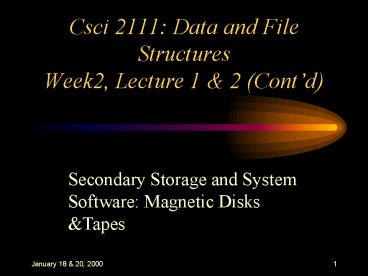Csci 2111: Data and File Structures Week2, Lecture 1 - PowerPoint PPT Presentation
Title:
Csci 2111: Data and File Structures Week2, Lecture 1
Description:
No direct accessing facility, but very rapid sequential access. Compactness, resistance to rough environmental conditions, easy to store and ... – PowerPoint PPT presentation
Number of Views:21
Avg rating:3.0/5.0
Title: Csci 2111: Data and File Structures Week2, Lecture 1
1
Csci 2111 Data and File StructuresWeek2,
Lecture 1 2 (Contd)
Secondary Storage and System Software Magnetic
Disks Tapes
2
Part II Tape Outline
- Description of Tape Systems
- Organization of Data on Nine-Track Tapes
- Estimating Tape Length Requirements
- Estimating Data Transmission Times
- Disk versus Tape
3
Description of Tape Systems
- No direct accessing facility, but very rapid
sequential access. - Compactness, resistance to rough environmental
conditions, easy to store and transport, cheaper
than disk - Used to be used for application data
- Currently, tapes are primarily used as archival
storage.
4
Organization of Data on Nine-Track Tapes I
- On a tape, the logical position of a byte within
a file corresponds directly to its physical
position relative to the start of the file. - The surface of a typical tape can be seen as a
set of parallel tracks each of which is a
sequence of bits. These bits correspond to 1 byte
a parity bit. - One Byte a one-bit-wide slice of tape called a
frame.
5
Organization of Data on Nine-Track Tapes II
- In odd parity, the bit is set to make the number
of bits in the frame odd. This is done to check
the validity of the data. - Frames are organized into data blocks of variable
size separated by interblock gaps (long enough to
permit stopping and starting)
6
Estimating Tape Length Requirements I
- Let b the physical length of a data block
- Let g the length of an interblock gap, and
- Let n the number of data blocks.
- The space requirement, s, for storing the file is
s n (bg) - b blocksize (i.e., bytes per block)/ tape
density (i.e., bytes per inch)
7
Estimating Tape Length Requirements II
- The number of records stored in a physical block
is called the blocking factor. - Effective Record Density a general measure of
the effect of choosing different block sizes
(number of bytes per block)/ (number of inches
required to store a block) - gt Space utilization is sensitive to the
relative sizes of data blocks and interblock gaps.
8
Estimating Data Transmission Times
- Normal Data Transmission Rate (Tape Density
(bpi)) (Tape Speed (ips)) - Interblock gaps, however, must be taken into
consideration gt Effective Transmission Rate/
((Effective Recording Density) (Tape Speed))
9
Disk versus Tape
- In the past Both Disks and Tapes were used for
secondary storage. Disks were preferred for
random access and tape was better for sequential
access. - Now (1) Disks have taken over much of secondary
storage gt Because of the decreased cost of disk
memory storage - Now (2) Tapes are used as Tertiary storage
(Cheap, fast easy to stream large files or sets
of files between tape and disk)































